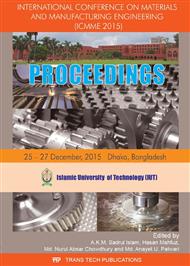p.35
p.41
p.46
p.52
p.58
p.64
p.70
p.74
p.81
Tool Life Improvement by Externally Applied Ultrasonic Waves in Cutting Process of Dry Turning Operation of Mild Steel
Abstract:
Tool wear is an inevitable impediment in machining processes. It is the gradual failure of cutting tools due to regular use. Tool wear affects productivity, dimensional accuracy thereby indirectly representing a significant portion of the machining costs. In this paper, a novel technique has been proposed and adopted with an aim to reduce tool wear. External ultrasonic sound waves were applied in the turning process of mild steel in an attempt to reduce the cutting tool vibration thereby leading to improvements in tool life. In this unique technique ultrasonic sound has been applied from the both sides of the tool holder in the cutting process as waves to reduce tool vibrations and improvement of chip behavior at a certain optimized frequency. Experiments were carried out at 60 KHz ultrasonic frequency to determine the tool wear to the best degree possible. To investigate the cause of ultrasonic effects on tool wear, cutting tool vibration and chip morphology were also studied. The experimental results showed significant improvements in tool wear, vibration and chip behavior.
Info:
Periodical:
Pages:
58-63
Citation:
Online since:
December 2016
Keywords:
Price:
Сopyright:
© 2017 Trans Tech Publications Ltd. All Rights Reserved
Share:
Citation:


